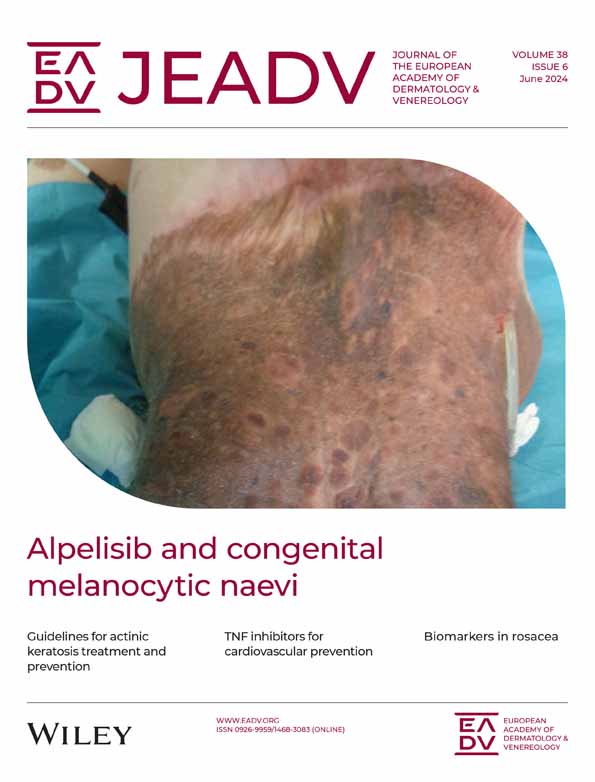Biomarkers for rosacea?
Linked article: R. S. Q. Geng et al. J Eur Acad Dermatol Venereol 2024;38:1048–1057. https://doi.org/10.1111/jdv.19732.
The Food and Drug Administration (FDA) defines a biomarker as a substance with a ‘characteristic that is objectively measured and evaluated as an indicator of normal biologic and pathogenic processes, or pharmacologic responses to a therapeutic intervention’.1 Geng et al. reviewed biomarkers for rosacea finding that levels of IL-1β, TNF-α, IL-37, IFN-γ and MMP-9 changed in rosacea. However, such changes may be compensatory reactions to the disease, secondary changes unrelated to the pathogenic pathway or the result of other concurrent inflammatory conditions.
To assess the causative role of a factor, measuring its level is not particularly informative. The statement that ‘elevated levels of cathelicidin, KLK5, TLR2, MMP-9, inflammasome proteins, and neutrophil and macrophage markers in rosacea skin compared to normal skin’ supports an association to a specific pathogenic pathway is not supported by the evidence presented.2 Instead, demonstrating that a specific inhibitor of a presumed biomarker inhibits the disease or finding that the presumed biomarker is genetically linked to the disease would be stronger evidence of causal association. Therefore, identification of biomarkers on the basis of changes in their levels in diseased skin does not necessarily mean they are good targets for future intervention.
Biomarkers may offer diagnostic utility when they are easily measured, and the disease is not.3 This is rarely the case for skin conditions. Facial redness in rosacea may be easier to measure and quantify through clinical diagnosis than analysis of the presumed biomarkers. Obtaining biomarker blood levels may be useless for assessing the severity of a local skin condition, and other diagnostic methods such as facial biopsies are invasive. Additionally, the heterogeneity of skin may make the measurement of a biomarker variable depending on where the biopsy is taken or where within the sample the biomarker is assessed.
The authors of this review concluded that the identification of biomarkers offers an objective measure of treatment efficacy through their correlation with clinical outcomes. If the value biomarkers offer is their correlation to clinical outcomes, perhaps utilizing clinical outcomes as a direct measure—a measure which can be assessed easily and in a non-invasive manner would make the biomarker superfluous. Objective facial photographic analysis systems designed to provide quantitative data on facial redness in patients with rosacea may be of value.4 These systems may offer algorithms that avoid human subjectivity and interobserver differences while being less costly, less invasive and more accurate than biomarkers.4
The authors suggest that biomarkers may be valuable for assessing treatment efficacy in recalcitrant cases of rosacea. Recalcitrant disease could be largely due to poor adherence to treatment. Biomarkers are unlikely to be informative about treatment adherence. Having good measures for adherence may be a much more valuable clinical tool.
Though there may be some scientific value in assessing biomarker levels for rosacea, it is not clear what that is since association does not indicate causality. The clinical benefit of biomarkers for rosacea (or other cutaneous skin diseases traditionally measured visually) is not supported based on the evidence available.1, 3 The conclusion that there is potential for biomarkers to aid in diagnosis and support therapeutic development for rosacea cannot yet be made.
CONFLICT OF INTEREST STATEMENT
Feldman has received research, speaking and/or consulting support from Eli Lilly and Company, GlaxoSmithKline/Stiefel, AbbVie, Janssen, Alovtech, vTv Therapeutics, Bristol-Myers Squibb, Samsung, Pfizer, Boehringer Ingelheim, Amgen, Dermavant, Arcutis, Novartis, Novan, UCB, Helsinn, Sun Pharma, Almirall, Galderma, Leo Pharma, Mylan, Celgene, Ortho Dermatology, Menlo, Merck & Co, Qurient, Forte, Arena, Biocon, Accordant, Argenx, Sanofi, Regeneron, the National Biological Corporation, Caremark, Teladoc, Eurofins, Informa, UpToDate and the National Psoriasis Foundation. He is the founder and part owner of Causa Research and holds stock in Sensal Health. Parraga has no conflicts to disclose.
Open Research
DATA AVAILABILITY STATEMENT
Data sharing not applicable to this article as no datasets were generated or analysed during the current study.




